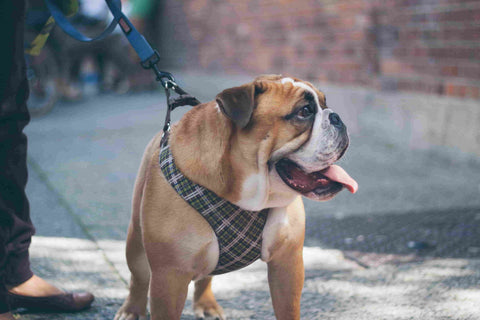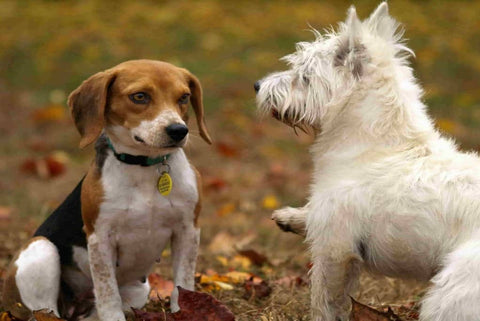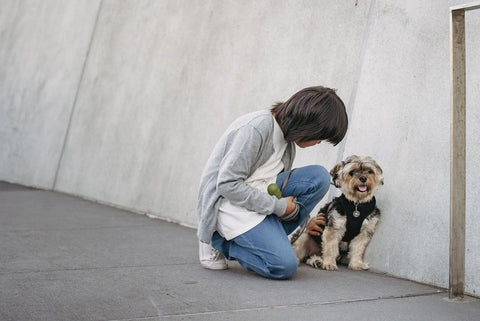Are Harnesses Good for Dogs?
If you’ve ever wondered whether or not a harness is good for dogs, the good news is, the answer is yes!
Using a dog harness gives more control than traditional collars and you can train your dog not to pull while you’re walking. They’re safer and reduce the risk of neck injuries and escape.
When you choose the right type of harness and the perfect leash, your dog is happy and comfortable, so walks become a daily highlight for both of you.
Should You Use a Dog Harness?
Dog harnesses are a collar alternative that many owners often find they prefer. They work for any breed and any size dog, offering versatility.
For example, whether you take casual walks around the block, or you’re running or hiking, a dog harness is a good option.
Pros and Cons of Dog Harnesses
You’re likely to find that all the upsides of using a dog harness far outweigh any possible downsides.
What to Love About Dog Harnesses
- Perhaps the biggest upside of a dog harness that makes it optimal for all types of dogs and situations is the level of control it offers.
- There are pressure points all around your dog’s body, as opposed to a collar where all the pressure is focused on its neck.
- Using a harness, your dog is going to learn how to be a better walker. When you’re not struggling, you’ll also enjoy yourself more.
- Harnesses for dogs help train them to stop pulling when you’re walking.
- It’s harder to escape compared to a collar.
Is There Anything Else to Consider?
While they’re minimal there are a few things to think about.
- Some dogs don’t like a harness at first. The issue here is that they take time for some dogs to get used to, particularly if you were using a collar.
- Work your way into having your dog use their harness more, so it becomes more natural for them. Most dogs quickly start to enjoy them with consistent use.
- A dog harness can take a bit longer to put on just because there’s more to it. The more you use it, much like your dog, the more you’ll get used to it. For the vast majority of dog owners, taking a little longer to put it on is nothing compared to the benefits.
- Dog harnesses are a bit bulkier than collars, so you’ll need to account for that if you’re traveling with it.
What Features to Consider in a Dog Harness
If you keep the following in mind, it’ll make it easy to choose the best dog harness to use every day.
- Safe design: One of the big benefits of using a harness versus a collar is safety. It should be designed to prevent choking. Look for one that specifically says it’s a non-pulling and no-choke design, with padding.
- Easy to use: You might explore a couple of different dog harnesses and see which is easiest for you personally to use. You don’t want an overly complex design, and you want something that’s easy to take on and off.
- Adjustable belts: It should fit well, and adjustable belts help customize the fit to your dog.
- Weight: Choose a lightweight yet durable harness that you can take anywhere you go.
- Clip location: When you choose a dual-clip harness, there are two metal leash attachments located at the back and front of your dog’s chest. You can use the front clip on walks to prevent pulling. The top ring is good for walking, hiking, and jogging.
- Reflective straps: Having a reflective element can keep you both safe, especially if you prefer early morning or evening walks.
- Material: Choose a soft material that’s gentle on your dog’s skin and isn’t going to cause uncomfortable rubbing or injuries. As far as the material of the D clips, choose metal for durability and longevity.
Harnesses vs. Collars
Dog harnesses are a better choice than a conventional collar in almost every situation.
- There’s a sense of control and power over your dog and will help you train them not to pull on walks. Not pulling is important for comfort and safety.
- A dog harness is more difficult to escape from than collars.
- Harnesses evenly distribute pressure across your dog’s body, rather than putting too much uncomfortable and potentially dangerous pressure just on their neck.
How to Use a Harness Properly
Get the hang of using a harness with the steps below:
- Stand, squat, or sit behind your dog while your dog is in a sitting position. Try to put on a harness when your dog is calm.
- Slip it over their head and make sure the D-ring is at the back. The loop with the buckle goes on first, then the loop that’s narrower goes on.
- Put your dog’s leg through the first hole and buckle it with the other leg then in the other hole.
- If your buckle doesn’t let you close it, you should loosen the harness.
- Once you buckle it, make adjustments to ensure the proper fit. You should test the fit by trying to pull it over your dog’s head to make sure it’s secure enough.
Choosing the Right Dog Harness Fit
Fit is critical in ensuring that you choose the best harness for your dog. Do the following to check the fit:
- Get your dog’s measurements. These include their neck girth, which is measured at the base of the neck, and belly girth, which is about an inch in front of your dog’s back legs.
- Check your dog’s body length, from behind the front leg to immediately behind the rear leg.
- Once you have these measurements, compare them to the size chart of the harness you’re considering.
- You should now have the right fit.
Tips on Using a Dog Harness
Before you begin the steps above to put on your dog’s harness, you should unbuckle it and lay it on the ground in front of your dog. Then, your dog can stand over it, and you can place it on their back. You can then follow the steps above or find what works best for you and your dog.
Once it’s on, make sure it fits properly. A dog harness should be snug enough to fit securely but not so tight that your dog isn’t able to breathe or move normally.
It shouldn’t be digging into the area under your dog’s arms or riding up onto their neck.
You should only put a harness on as you’re preparing for a walk and then take it off when you return.
Is it Safe to Use a Retractable Leash with a Harness?
A dog harness and a retractable leash used together can certainly be a safe option, with a few things in mind.
Choose a retractable leash with the right weight limit for your dog. Get one that’s made with durable parts, and a length that’s only what you need. A retractable leash that’s too long can be inconvenient and even dangerous.
When you’re using a retractable leash, don’t use the attachment point in front of your dog unless you’re training him. That can pinch your dog’s shoulders together. Instead, make sure you’re using a top attachment point.
If you do use the front clip with a retractable leash, be careful to give some slack in the leash because otherwise, your dog will think he’s pulling even if he’s not because of the sensations.
As always, when using a retractable leash, be mindful and alert about your surroundings.
If you’re interested in choosing a safe, well-made, and high-quality harness for your dog, we encourage you to browse Pet&Cuddle’s selection. Our dog harnesses meet all of the above standards and then some.
Questions About Dog Harnesses
The following are answers to some of the most common questions you may have.
Can You Use a Harness with a Puppy?
Yes, you can absolutely use a harness with a puppy. In fact, you should, although most vets recommend waiting until your puppy is eight months old. A harness helps a puppy with their leash training, so they learn how to walk without pulling. As your puppy is learning how to walk properly on a leash, it can also help avoid neck pain or injury.
How to Fit a Dog Harness Properly?
When you fit a dog harness:·
- Measure your dog’s neck girth, belly, and length.
- Then, once you have these measurements, you can compare them to the size chart.
- Once a harness is on your dog, it should be tight enough that it’s secure, but never too tight to the point that it’s hurting your dog or restricting their movement.
- Typically, you should be able to fit two fingers within the harness at any point.
For more information about properly fitting your dog’s harness, see the above section.
What Are No-Pull Harnesses?
A no-pull dog harness is one with a front clip attachment for the leash. This teaches a dog not to pull when you’re walking because if they do, it becomes uncomfortable for them. It pulls their shoulders together.
This is actually a safer, kinder option than using something like a choke or pinch collar to teach a dog not to pull.
Can Dogs Wear a Harness 24/7?
A dog should not wear a harness all the time. You should put it on and take it off based on your walks.
If your dog wears a harness too long, it can rub and be uncomfortable on their skin, especially if they have long fur.
Front Clip vs. Top Clip Dog Harnesses
There are front clips and then top clip harnesses. A lot of designs come with dual clips, so you have the option of using both.
A front-clip dog harness is used as you’re teaching your dog how to walk and to avoid pulling. However, once your dog is well-trained and doesn’t pull on your walks, you should use the top clip instead of the front because it’s more comfortable.
With a dual-clip dog harness, you can take advantage of both options as you need to, which you may prefer.
Which Dog Harness Should I Get?
To get the right harness for your dog, check the latest collections of Pet&Cuddle. Our products are designed to provide maximum control, effective training features, and optimal safety for you and your dog.
Besides, our top-rated dog harnesses are comfortable and affordable, so there is always the best option you can choose for your pet. Our designers have created different sizes to ensure you can find the right harness for any breed.







